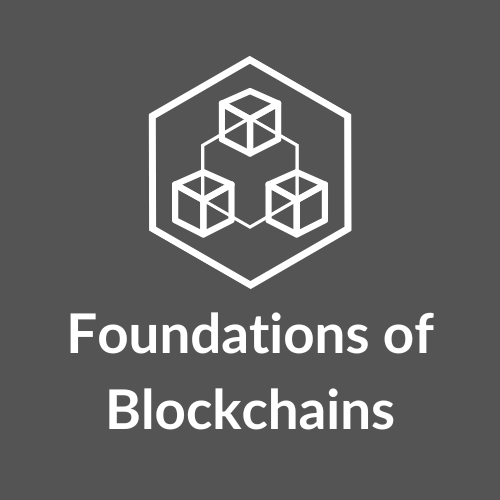Differences
This shows you the differences between two versions of the page.
|
fob:laboratoare:01 [2022/10/13 11:25] costin.carabas [Explorer] |
fob:laboratoare:01 [2022/11/10 20:16] (current) costin.carabas |
||
|---|---|---|---|
| Line 1: | Line 1: | ||
| - | ===== Practical Session 01. ===== | + | ===== Intro ===== |
| Today's practical session will be about having a practical overview over the blockchain. | Today's practical session will be about having a practical overview over the blockchain. | ||
| Line 7: | Line 7: | ||
| ==== Explorer ==== | ==== Explorer ==== | ||
| - | We will use Elrond, Ethereum and Bitcoin as examples. | + | In this practical session we will use Elrond, Ethereum and Bitcoin as examples. |
| We will inspect each blockchain explorer and see how each participant interacts with the blockchain. | We will inspect each blockchain explorer and see how each participant interacts with the blockchain. | ||
| A blockchain Explorer is a software for visualizing blocks, transactions, and blockchain network metrics (e.g., average transaction fees, hashrates, block size, block difficulty). | A blockchain Explorer is a software for visualizing blocks, transactions, and blockchain network metrics (e.g., average transaction fees, hashrates, block size, block difficulty). | ||
| + | |||
| + | Whereas under proof-of-work, the timing of blocks is determined by the **mining difficulty**, in proof-of-stake, the **tempo is fixed**. Time in proof-of-stake: | ||
| + | * Elrond is divided into rounds (6 seconds) and epochs (24 hours); | ||
| + | * Ethereum is divided into slots (12 seconds) and epochs (32 slots). | ||
| === Elrond === | === Elrond === | ||
| Line 32: | Line 36: | ||
| The upgrade from the original proof-of-work mechanism to proof-of-stake was called The Merge (you can search online more about this). | The upgrade from the original proof-of-work mechanism to proof-of-stake was called The Merge (you can search online more about this). | ||
| + | Go to Ethereum's explorer [[https://etherscan.io/|Link]]. | ||
| + | |||
| + | Browser the explorer to see: | ||
| + | * Blockchain metrics | ||
| + | * Blocks | ||
| + | * Transactions in the blocks | ||
| + | * Proposer/Leader | ||
| + | * Consensus Group (number of participants and the actual participants) | ||
| + | * Leader: Latest Consensus Round | ||
| + | * Validators | ||
| + | * Observers | ||
| + | |||
| + | === Bitcoin === | ||
| + | |||
| + | Bitcoin uses proof-of-work. | ||
| + | The proof-of-work algorithm used by Bitcoin aims to add a new block every 10 minutes. To do that, it adjusts the difficulty of mining Bitcoin depending on how quickly miners are adding blocks. If mining is happening too quickly, the hash computations get harder. If it's going too slowly, they get easier. | ||
| + | |||
| + | |||
| + | |||
| + | Go to Bitcoin's explorers [[https://www.blockchain.com/explorer|here]] or [[https://btcscan.org/|here]]. | ||
| + | |||
| + | Browser the explorer to see: | ||
| + | * Blockchain metrics | ||
| + | * Blocks | ||
| + | * Transactions in the blocks | ||
| + | * Proposer/Leader | ||
| + | * Consensus Group (number of participants and the actual participants) | ||
| + | * Leader: Latest Consensus Round | ||
| + | * Validators | ||
| + | * Observers | ||
| ==== Wallet ==== | ==== Wallet ==== | ||
| + | In this task we will use Elrond blockchain to create a wallet and make transactions on the blockchain. | ||
| + | |||
| + | Elrond has 3 different blockchains: Mainnet, Devnet and Testnet. We will use Elrond Testnet to participate in the blockchain as a user. | ||
| + | |||
| + | - Create a wallet on Elrond Testnet using [[https://testnet-wallet.elrond.com/|this link]]. Each wallet will have 24 secret words that can be used for recovery. Follow the tutorial; | ||
| + | - Login on Elrond Testnet using the credentials from step1; | ||
| + | - Explore the Wallet and its functionalities; | ||
| + | - Use the **Faucet** functionality to obtain xEGLD tokens. Bear in mind that these tokens are only available on Elrond Testnet | ||
| + | - Make a transaction to the address **erd136m9fdc0phlcfyn6lx9qzqhmk5er5f2fkuepnr2enm5nngpw8wjs4mcsp4** | ||

